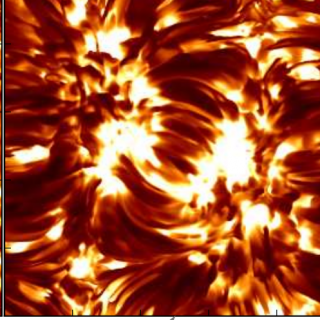Bibcode
Kuckein, C.; Collados, M.; Manso Sainz, R.
Referencia bibliográfica
The Astrophysical Journal Letters, Volume 799, Issue 2, article id. L25, 5 pp. (2015).
Fecha de publicación:
2
2015
Número de citas
19
Número de citas referidas
15
Descripción
This Letter reports on a set of full-Stokes spectropolarimetric
observations in the near-infrared He i 10830 Å spectral region
covering the pre-flare, flare, and post-flare phases of an M3.2 class
solar flare. The flare originated on 2013 May 17 and belonged to active
region NOAA 11748. We detected strong He i 10830 Å emission in the
flare. The red component of the He i triplet peaks at an intensity ratio
to the continuum of about 1.86. During the flare, He i Stokes V is
substantially larger and appears reversed compared to the usually larger
Si i Stokes V profile. The photospheric Si i inversions of the four
Stokes profiles reveal the following: (1) the magnetic field strength in
the photosphere decreases or is even absent during the flare phase, as
compared to the pre-flare phase. However, this decrease is not
permanent. After the flare, the magnetic field recovers its pre-flare
configuration in a short time (i.e., 30 minutes after the flare). (2) In
the photosphere, the line of sight velocities show a regular granular
up- and downflow pattern before the flare erupts. During the flare,
upflows (blueshifts) dominate the area where the flare is produced.
Evaporation rates of ˜ {{10}-3} and ˜
{{10}-4} g cm‑2 s‑1 have
been derived in the deep and high photosphere, respectively, capable of
increasing the chromospheric density by a factor of two in about 400 s.
Proyectos relacionados

Magnestismo Solar y Estelar
Los campos magnéticos son uno de los ingredientes fundamentales en la formación de estrellas y su evolución. En el nacimiento de una estrella, los campos magnéticos llegan a frenar su rotación durante el colapso de la nube molecular, y en el fin de la vida de una estrella, el magnetismo puede ser clave en la forma en la que se pierden las capas
Tobías
Felipe García

Magnetismo, Polarización y Transferencia Radiativa en Astrofísica
Los campos magnéticos están presentes en todos los plasmas astrofísicos y controlan la mayor parte de la variabilidad que se observa en el Universo a escalas temporales intermedias. Se encuentran en estrellas, a lo largo de todo el diagrama de Hertzsprung-Russell, en galaxias, e incluso quizás en el medio intergaláctico. La polarización de la luz
Ernest
Alsina Ballester